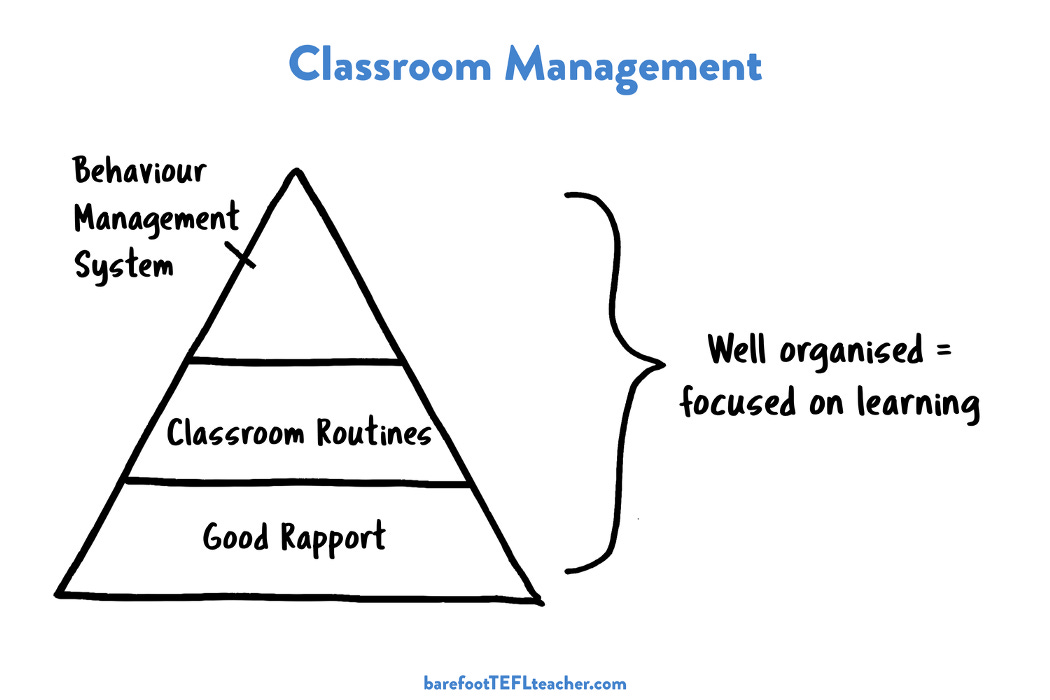How to Master Classroom Management
To keep you and your students sane.
Contrary to popular opinion, routines don’t make the class boring - they free up energy and time for fun.
Routines are your best friend because they:
Save you from having to reinvent the wheel every time you do something.
Help even the slowest student know what’s coming next and feel confident.
Help your classroom and behaviour management like you would not believe.
Imagine two teachers; Teacher A has no routines, but good Teacher B does.
Teacher A
Teacher A does things differently every time. Not a lot, but enough that he has to explain to the students how to do things, so the students are forced to use some of their limited reservoir of attention listening to instructions for the boring stuff. All this takes time in class. The students often get it wrong, too, especially the younger and lower-level learners. This leads to more time wasted in correcting them. The students start to misbehave as their attention wanders.
Teacher B
Teacher B has a routine for all those routines. When she starts a new class, she takes some time to explain her routines. This is how we store our bags under our chairs, that is how we take attendance, this is how we divide into pairs, and so on.
Before long, Teacher B is flying through the lessons as students are used to what and how to do the routines in class. Behaviour is good as students know what is expected of them at transition points in the class. Teacher A, however, still struggles with getting his students to do what he wants them to do. As a result of this lingering uncertainty, behaviour is still an issue, and classes are much more tiring.
Now, do you see what a huge impact classroom routines can have?
Which routines do I need?
While every great teacher has their list, there are some routines that everyone should have:
Taking attendance
Handing out worksheets
Collecting worksheets/homework
Writing on the board.
Putting the class into pairs
Giving instructions
Taking out / putting away materials
Asking questions
Answering questions
Going to the bathroom
Finishing work early
OK, but what about the procedures?
Every teacher finds what works best for them over time. To start with, do all the routines mentioned above the same way until your students get used to them.
By then, you’ll have a good idea of the students you have in class and what they’ll best respond to. Then you can change routines—but only one at a time! Again, when you change a routine, give the students time to get used to it before changing another.
Be careful not to change too many routines at once, or your learners won’t be able to tell the difference between routine change and chaos.
I’d also suggest observing your colleagues or asking them how they do each of those you want to implement. Try out their suggestion and if you like it.
If you liked this article, you’ll love my books:
📝 Lesson Planning for Language Teachers - Plan better, faster, and stress-free (4.5⭐, 175 ratings).
👩🎓 Essential Classroom Management - Develop calm students and a classroom full of learning (4.5⭐, 33 ratings).
🏰 Storytelling for Language Teachers - Use the power of storytelling to transform your lessons (4.5⭐, 11 ratings).
🤖 ChatGPT for Language Teachers - AI prompts and techniques for language teachers (4.5⭐, 10 ratings).
💭 Reflective Teaching Practice Journal - Improve your teaching in five minutes daily (4.5⭐, 16 ratings).



